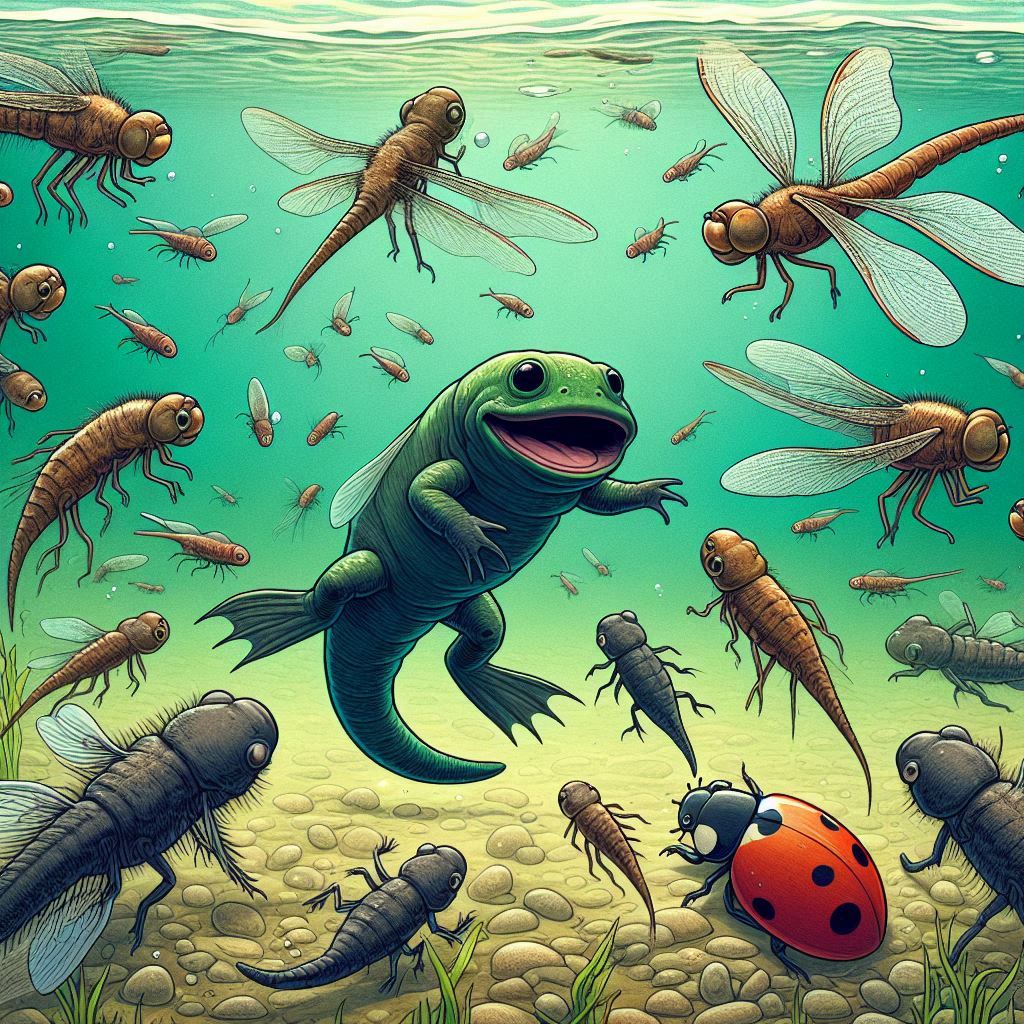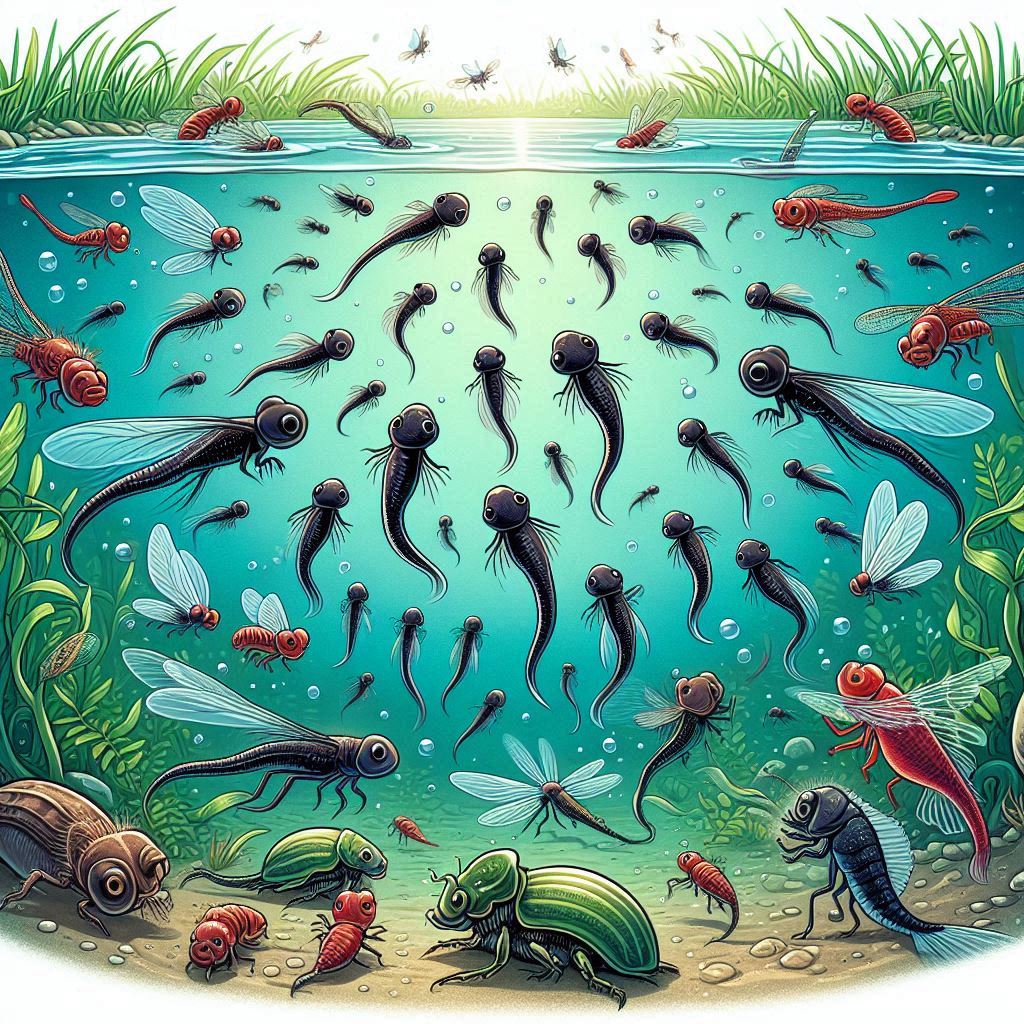
Each year, as temperatures warm, ponds and wetlands come alive with masses of tadpoles hatched from gelatinous globs of eggs laid by various amphibian species. Male and female adult frogs and toads must migrate each springtime from woodlands and fields toward specific aquatic sites to mate and spawn.
Following external fertilization, each adult female produces vast numbers of eggs since few will survive to full development. Shortly after egg laying, legless tadpole larvae emerge and school together by the thousands for protection within nourishing nursery sites.
Lacking limbs, tadpole locomotion depends on vertical tail fins to propel through water while breathing via gills. During the ensuing weeks, tadpoles face grave challenges from innumerable hungry predators who are able to take advantage of the helpless leggy larvae.
Tadpoles fall prey and are eaten by many aquatic and terrestrial predators including many fishes, birds, water insects, reptiles such as lizards, turtles and snakes and amphibian like frogs, toads and salamanders and even mammals
Expanded List Of Predators That Feed On Tadpoles:

Aquatic Water Predators
Fish
Description: Fish are one of the primary predators of tadpoles. Species like bass, trout, and perch are especially notable for preying on tadpoles.
Hunting Method: Fish use their keen vision to detect movement and quickly swoop in to eat tadpoles. Both large fish like pike and bass and smaller species like minnows can decimate tadpole populations by consuming them in large quantities.
Dragonfly Nymphs
Description: Dragonfly nymphs are formidable aquatic predators.
Hunting Method: These larvae use extendable jaws to snatch tadpoles, often relying on stealth and ambush tactics. They are highly effective at capturing tadpoles due to their quick and precise movements.
Water Beetles
Description: Both larvae and adult water beetles are known to prey on tadpoles.
Hunting Method: Water beetles are agile swimmers and use their sharp mandibles to catch and consume tadpoles. They often target the younger and more vulnerable tadpoles.
Newts and Salamanders
Description: Newts and salamanders are amphibians that often consume tadpoles.
Hunting Method: These predators use their agility and predatory instincts to catch tadpoles, taking advantage of their shared aquatic habitats.
Aquatic Snakes
Description: Certain snakes, such as water snakes, hunt tadpoles in aquatic environments.
Hunting Method: Aquatic snakes rely on their speed and stealth to capture tadpoles, often in shallow waters where tadpoles are abundant.
Birds
Description: Birds, including waterfowl and wading birds like herons and ducks, prey on tadpoles.
Hunting Method: Birds use their sharp beaks to scoop up tadpoles from the water. Wading birds like herons and egrets use their long legs to stalk and spear tadpoles, while ducks and other waterfowl scoop them up as they swim.
Terrestrial Predators
Frogs and Toads
Description: Adult frogs and toads sometimes eat tadpoles, especially when other food is scarce.
Hunting Method: These amphibians use their speed and predatory skills to capture tadpoles, contributing to the complex dynamics of their ecosystems.
Mammals
Description: Small mammals such as raccoons and otters can hunt tadpoles.
Hunting Method: These animals forage in and around aquatic environments, using their dexterous paws and sharp senses to locate and capture tadpoles.
Insects
Description: Certain insects, like water striders, prey on tadpoles.
Hunting Method: Water striders and similar insects capture tadpoles at the water surface using their piercing mouthparts.
General Predators
Larger Amphibians
Description: Larger amphibians, including adult salamanders and giant salamanders, may prey on tadpoles.
Hunting Method: These predators use their size and strength to overpower and consume tadpoles.
Birds of Prey
Description: Predatory birds, such as hawks and eagles, may eat tadpoles if they are accessible.
Hunting Method: These birds use their keen eyesight to spot tadpoles from above and swoop down to catch them.
Reptiles
Description: Some reptiles, like lizards and turtles, might feed on tadpoles.
Hunting Method: Turtles use their strong jaws to catch tadpoles, while lizards rely on their agility to capture them.
Additional Predators
Leeches
Description: Leeches are significant parasites of tadpoles, often found in the same backwater ponds, lakes, and wetlands where frogs breed.
Hunting Method: Leeches detect tadpoles and swiftly attach to them, drawing out fluids through incisions. They secrete anesthetics at the wound site, allowing them to remain attached for weeks. Large leeches can directly kill weakened tadpoles through blood loss, while smaller ones parasitize masses, stunting development and leading to organ failure in the host.
Turtles
Description: Freshwater turtles, including species like painted turtles, sliders, cooters, map turtles, and the Common Snapping Turtle, are adept at hunting tadpoles.
Hunting Method: Turtles use their snake-like necks to snatch tadpoles and eggs, often waiting motionless for egg masses to appear. They pounce on deployment sites to gulp down gelatinous bunches before guardians return, consuming hundreds of tadpoles in minutes.
Defense Mechanisms
Tadpoles have a variety of strategies to avoid predation, such as hiding in vegetation, moving in schools, or rapidly swimming away when threatened. However, despite these defenses, many tadpoles do fall prey to these predators.
These predatory relationships are crucial in maintaining the balance within ecosystems and understanding the survival challenges faced by tadpoles during their development. Tadpoles experience up to 99 percent mortality prior to completing metamorphic changes into mature tetrapods, and only by producing large numbers of offspring can amphibian species endure overall.
